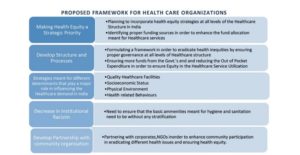
How to prioritise the allocation of the resources to the most eminent tier of the healthcare structure
India, next only to China in population, faces the herculean task of not only feeding and clothing its teeming millions but also in providing adequate healthcare to all. Although, giant strides have been taken by the government in this direction to overcome the problem of healthcare, yet they all seem inadequate when it comes to high-end health facilities for the poor and those people living in far off and remote villages. The poor cannot afford it and for those in far off places, it is inaccessible due to poor connectivity.
India is divided on its opinion on several issues, and so also in healthcare. This too is unequally distributed. Here
too as per our research, it is based on affordability, gender, accessibility and finally caste. In the urban areas, this is mainly affordability that matters. In the rural areas, the discrimination is gender-based, which means men receive more priority over women when it comes to nutritional food, education, and finally better healthcare facilities. Next is the caste of the person. Even today, rural India is highly caste-based where the society is divided into watertight compartments of high caste and low caste or worse may be the problem of untouchability that persists and plagues the lives of people. Finally, we have the twin problems of unavailability of primary healthcare centres and lack of accessibility to the nearest healthcare centre or district hospital.
The proposed framework consists of five major dimensions which revolve around the basic determinants which can be used to measure the performance of healthcare organisations based on health equity.
The dimensions were:
• Making health equity a strategic priority
• Develop structure and processes
• Strategies meant for different determinants that play a major role in influencing the healthcare demand in India;
• Decrease in institutional racism;
• Develop a partnership with a community organisation.
Although there is no dearth of good hospitals, healthcare centres and clinics are spread everywhere, but the
question is how many of India’s urban poor can afford it. They finally rely on the government hospitals where the
apathy of doctors and paramedics puts their lives at risk and chance. Hence, it has been mandating for the government to make health equity a major concern and their strategies should revolve around the same. The government has tried its best to bring facilities into the system by providing a proper flow of funds in the sector. Hospitals may have facilities like laboratories, labour rooms and also blood banks but are they functioning properly? In many cases, the labour rooms are used as storerooms, laboratories are left unused and uncared for and all the testing that could have been carried out there are diverted to private testing laboratories. So is the case with blood banks which also are used for purposes other than they should be. Hence, how to ensure proper healthcare? Can there be a monitoring agency that can look into the affairs of the health centres, the inadequacies they suffer from, improper use of existing infrastructure and proper utilisation of equipment etc?
Due to poverty, the urban poor can ill afford the cost of treatment in reputed private hospitals and as stated above the primary health centres and government hospitals that are there do not function that well. In the case
of health equity, despite certain steps by the government, the condition is far from satisfactory as the poor continue to suffer from the lack of proper treatment due to poverty.
The government has ensured funding for the poor under certain schemes. But due to the lack of proper awareness, this facility remains unutilised. Other than the economical factors, there are many social factors, which have acted as great hurdles in the path for health equity. These factors range from various socio-economic
aspects to behavioural aspects which can only be taken care of by bringing proper community participation and
involvement and for this, we need to change the mindset of people towards health and hygiene. The scene in rural areas is even worse considering the poor personal hygiene practised. It is this lack of proper hygiene that leads to a high level of infant mortality rates in villages. This has been a major challenge for healthcare officials to combat.
How about roping in the corporates for such CSR activities wherein the corporate and the poor can benefit from
such schemes. This way the government can undertake such ambitious programmes through the PPP mode and
ensure its success.





